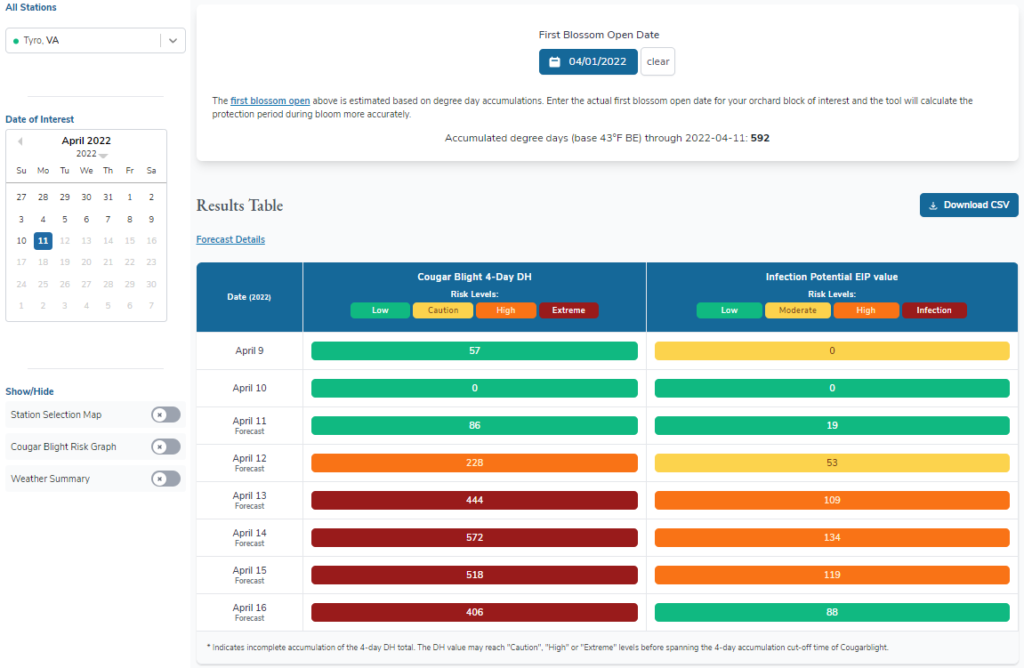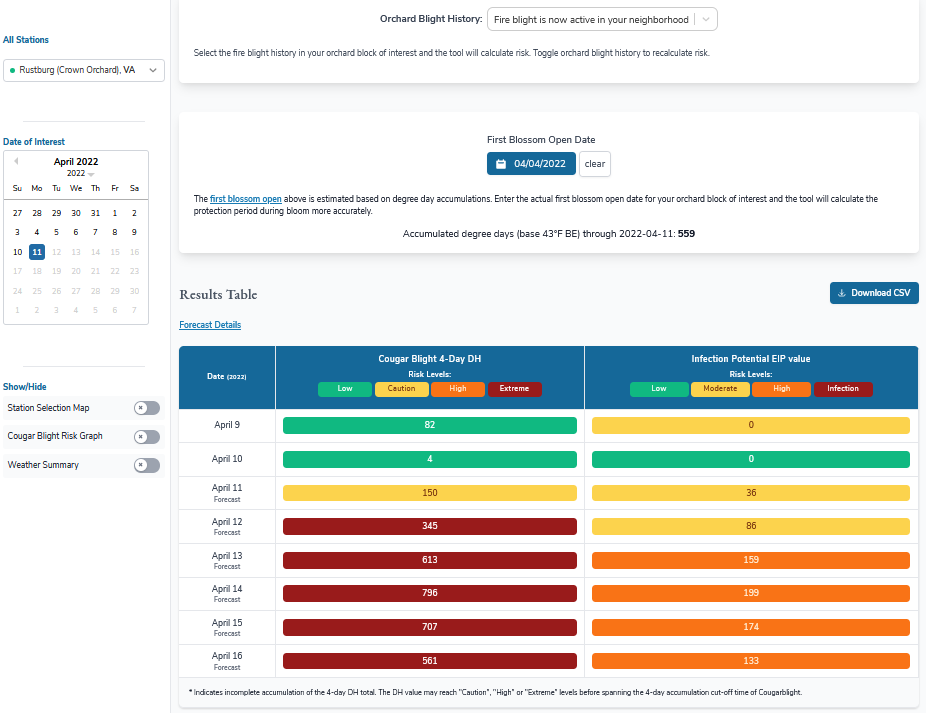Central and South VA in Apple Bloom – Look at MaryBlyt’s EIP Value in NEWA’s Fire Blight Model for Fire Blight Spray Considerations
(I) FIRE BLIGHT: Apple bloom started on early cultivars on 1st April (Tyro) or 4th April (Charlottesville) or 6th April (Fincastle) and it varies from location and your orchard elevation. We are at very early bloom in ‘Pink Lady’ in Winchester (less then 1 %). As per the NEWA’s EIP model we start to worry when we reach the Infection potential EIP value of ≥ 100 but keep in mind that ALL the conditions need to fulfill at the same time for a fire blight infection to occur:
1. Open(ing) young flowers,
2. Accumulated heat units for fire blight bacterial inoculum to reach the necessary cell numbers,
3. A wetting event (dew, rain, spray water) to wash bacteria down into the flower base (nectar glands),
4. Average temperature above 60F.
So, the weather forecast is the key for central and southern Virginia, which will lead you to decide how seriously should you consider applying streptomycin or not. If your Infection potential EIP value is at or above 100 and is shown in an orange color box like in two print screens below (right side of the NEWA fire blight model output shown below), that still means one of the factors for infection above is missing and that could be wetting event or temperature. Currently, there are warm to hot temperatures predicted for 12 – 16 April, but the weather forecast for the rain/thunderstorms on Wed – Thu (13 – 14 April) is highly variable from location to location. Here are two options to approach a spray decision:
OPTION 1: If you have large acreage and you want to be on a safe side thinking you will get the rain on 13 or 14 April, I would recommend you to cover before the predicted wetting event any apple and pear trees in bloom with streptomycin: Harbor, or Agrimycin 17, or Fire Wall 17 WP at 1.5 to 1 lb per acre (16 – 24 oz/A) plus LI 700 at a penetrating rate or Regulaid. Based on the Regulaid label, rate which ranges from 1 to 4 pints per 100 gallons of spray mixture, I would use a 2 pints penetrating rate. Keep in mind that FireWall has changed its formulation to FireWall 50WP and the rate to use this higher concentrated material is 8 – 16 oz./Acre. If you still have FireWall 17 WP in your shed use the rate of 24 – 48 oz./Acre as it is less concentrated.
OPTION 2: If you have a smaller acreage farm, the other option is to wait and see will you get the wetting event or not on 12-14 April, because the NEWA EIP model right now is showing that EIP is above 100 but it did not turn into a red box (infection) probably because rain is not predicted for these two locations I put below. So, whether the infection will occur or not will depend on whether rain will occur or during the days with EIP value 100 or above (keep an eye on the EIP model daily so you know will the rain prediction change or not). Then, if rain occurs, protect any blooming apple cultivars with streptomycin in mix with Regulaid or LI700 up to 24 h after the infection rain event (kick-back mode of application). In case you will use LI700 instead of Regulaid, use a penetrating action rate for LI700. If rain doesn’t occur, infection will not occur, unless you provide water with a fungicide spray application during 13-16 April which can and will trigger the infection. If you want to be on a cheaper side, Option 2 is a possibility you should consider.
*Note: In terms of timing your spray, I would trust more the EIP model in NEWA than the Cougarblight model. Keep in mind that changing the “Orchard Blight History” above the model will change how the risks for infection change in Cougarblight.
WARNING: If you used captan recently, which would not be my choice, DO NOT add Regulaid or LI700 to streptomycin for this bloom spray against fire blight. You could and should add fungicides to this spray to make it more economical, and a good choice would be mancozeb (3 lb/A) + either Aprovia, Fontelis, Sercadis, Miravis or Excalia. Previous data indicate that using Regulaid and other surfactants in repeated sprays (if one needs 2 or 3 applications of strep during bloom) will lead to significant amounts of leaf yellowing. Hence we suggest using Regulaid or LI 700 ONLY with the first strep spray application and then applying strep without the adjuvat in any subsequent sprays. Do NOT use Regulaid or LI700 with any sprays that contain thinning materials. Hence, strep included with a petal fall spray should NEVER be mixed with Regulaid or LI 700. Regulaid should NEVER be combined with captan, and other adjuvants that are sometimes used with captan and are generally applied at rates that will not provide the penetration effects that one gets with Regulaid. Thus, growers with a major fire blight threat this week must decide if using captan as a scab fungicide is more important to them than achieving the best possible fire blight protection (which requires a penetrating adjuvant, if it is a first fire blight spray of the season).


(II) APPLE SCAB & RUST: If the current weather forecast remains as it looks now, scab infection could occur but it might not be a severe one due to fast drying of leaves after rains 12-14 April. However, I would recommend you to apply fungicides along with streptomycin to make it more economical and to control rust, and a good choice would be mancozeb (3 lb/A) for rust and scab + either Aprovia, Fontelis, Sercadis, Miravis or Excalia for scab. The SDHI fungicides will work better against scab by adding the adjuvant for streptomycin. This cover with fungicides is needed because leaf mass will rapidly expand with warm weather e expect. So dilution of fungicide residue is not only caused by rain, but with the leaf tissues expansion as well. Be vigilant and look at the prediction models every day to see if any of these predictions will change and act accordingly (for example, if rains on 12 – 14th trigger slow leaf drying, I would replace the SDHI fungicide above with a DMI fungicide (Rally, Rhyme, or Procure, etc).
